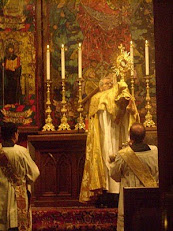
The February issue of this newsletter was completed in early January so that your editor could sneak away with his wife for a brief Florida vacation. The weather was splendid, thank you! That did, however, leave somewhat of a hole in terms of news developments between early January and this current issue.
In late January, Bishop Peter Wilkinson, along with Fr’s Birch, Malins and Henry (also representing Gale, Switzer and Braunstein) met with Bishop Gagnon of the Catholic Diocese of Victoria. The purpose of the meeting was to determine a way forward for the Victoria Fellowship of Blessed John Henry Newman.
And, just as in Waterloo a few months ago, the suggestion was to form a sodality -- which in this situation, as we anticipate the extension of the US Ordinariate of the Chair of St Peter to include a Canadian Deanery -- means a "parish in waiting". Which is to say, while they will be welcomed by Bishop Gagnon, his Victoria Diocese lays no claim on any assets; they remain the property of the fellowship/sodality/parish-in-waiting, as articulated in
Anglicanorum Coetibus.
The date chosen for this to occur is Easter I, April 15.
This has led to a certain amount of incorrect speculation. Some are suggesting that Bishop Wilkinson and the other clergy in the Victoria area have already left the ACCC. That is simply not correct. They will remain members until April 15.
Acknowledging this timetable, those who are already in the Pro-Diocese of Our Lady of Walsingham (headed imminently for the ordinariate), or are poised in that direction, have met or are about to meet with our respec- tive parishes, and, in many cases, also with the local Catholic (arch) bishop. In all cases, we have been met with the same profoundly co-operative spirit of helpfulness in creating sodalities as we await the formation of a Canadian Deanery of the Ordinariate of the Chair of St Peter. When Bishop Peter was in Houston in February he met with Mons Steenson for several hours. He confirmed that we would have such a Deanery and Bishop Peter asked if our patron could be St John the Baptist, our country’s old patron, and whose Octave Day is July 1, our national holiday. Mons Steenson readily agreed, and looks forward to coming to Canada again.
Other parishes are just having their meetings, or in some cases are some weeks away. We have communicated with the rectors in those cases, and have tried to reflect their respective understanding of what they, in discussion with their faithful, understand how the cards will fall. Calgary is perhaps the biggest challenge to understand: there is already an ordinariate parish there (St John the Evangelist); some of our Christ the King people have already moved there, more will be going on Easter, and, of the remaining approximately half, some will moving to that portion of All Saints that intends to remain in the Diocese of Canada, others will leave altogether. It appears that only a minority from All Saints will also join St John the Evangelist, with the majority remaining in the Diocese of Canada. We have tried to reflect this below, recognizing that this does not commit anyone to a particular position; it is only our best understanding at the time of printing:
Clergy (Parishes) remaining in the Diocese of CanadaBishop Craig Botterill (St Aidan’s, Halifax)
Dean Shane Janzen (St John the Evangelist, Victoria) Fr Douglas Ohs Fr Richard Root
Fr Trevor Elliot (Our Lady & St Michael, Edmonton)
(The majority of All Saints, and part of Christ the King, Calgary)
Fr Howard Patterson (Holy Trinity, Medicine Hat)
(St Barnabas, Moose Jaw -- now without a priest since the sudden death of Fr Dennis Dickson)
Fr Ted Bowles Fr Lee Whitney Fr Harley Kynock (St George’s, Mosers River)
Fr Fred Highmore (St Stephen, St Johns) Fr Fabian Ollerhead Fr Edward Fizzard Fr Dn Robert Short
Clergy (Parishes) seeking imminent inclusion in the Ordinariate (dates if known)Bishop Peter Wilkinson (Fellowship of Blessed John Henry Newman, Victoria-April 15)
Fr Michael Birch Fr Don Malins Fr Sean Henry Fr Ralph Braunstein Fr Edward Gale
Fr Peter Switzer
Bishop Carl Reid (Annunciation of the Blessed Virgin Mary, Ottawa-April 15)
Fr David Walsh
Fr Dn Henry Stauffenberg Fr Dn Michael Trolly
Fr Ernest Skublics (All Saints, Calgary-only part, date TBD)
Fr Dn Glenn Galenkamp
Fr Colin O’Rourke (Christ the King, Calgary-only part of parish, Apr 8)
Fr Lloyd Gedge
Fr David Skelton (Fellowship of Blessed John Henry Newman, Edmonton-April 15)
Fr Bryan Donegan
Fr Jim Tilley (Good Shepherd, Oshawa-April 15) Fr David Garrett
Fr Raymond Ball (already a sodality of St Edmund, Waterloo)
Fr Gérard Trinque (Christ the King, Tyendinaga-date TBD)
Fr Doug Hayman (St Barnabas, Spencerville-Apr 15)
Fr Kipling Cooper (Holy Nativity, Barrhaven-date TBD)
Fr Doug Nicholson (St Athanasius, Montreal-date TBD)
Fr. Oswald Slattery
Fr Charles Warner (Holy Cross, Sydney Forks-date TBD)
Fr Chris Le Page (St Thomas More, Charlottetown- date TBD)
UndecidedFr Michael Shier (St Peter & St Paul, Vancouver; St Michael, Matsqui)
Fr Jim Schovanek (All Saints, Calgary) Fr Douglas Skoyles
Fr Richard Harris (St Michael, Fredericton Jctn.) Fr John Hall
Fr Ron McBrine
Looking ahead to April 15, this March issue of the newsletter might possibly be the last produced in the Ottawa office of the ACCC, as the records will be moved to Victoria soon. Following that move, we might presume that, under Fr Shane Janzen’s management, a new newsletter, for what will become a one-diocese ACCC again, will be forthcoming.
As a final note, I pray that all of us, even as we may be parting ways, will continue in a spirit of mutual good will.
+Carl
from the
March Archdiocesan Newsletter of the ACCC
Hat tip to Br. Charles Gilman, o.s.b.





















